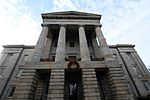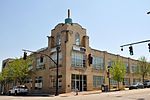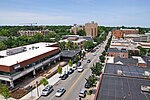Broughton High School (North Carolina)
1929 establishments in North CarolinaBroughton family of North CarolinaEducational institutions established in 1929International Baccalaureate schools in North CarolinaMagnet schools in North Carolina ... and 4 more
Public high schools in North CarolinaSchools in Raleigh, North CarolinaUse mdy dates from September 2019Wake County Public School System

Needham B. Broughton High School, commonly known as Broughton High School, is one of thirty-two high schools in the Wake County Public School System. It is located at 723 St. Mary's Street, Raleigh, North Carolina, United States. Broughton was named after businessman and politician, Needham B. Broughton, who contributed much to the public schools of the Raleigh area. Broughton is known for its castle-like stone facade design and tall bell tower. The architect was William Henley Deitrick.
Excerpt from the Wikipedia article Broughton High School (North Carolina) (License: CC BY-SA 3.0, Authors, Images).Broughton High School (North Carolina)
Avenue du Gros Tilleul, Bruxelles
Geographical coordinates (GPS) Address Nearby Places Show on map
Geographical coordinates (GPS)
| Latitude | Longitude |
|---|---|
| N 35.7902 ° | E -78.6524 ° |
Address
Avenue du Gros Tilleul - Dikkelindelaan
Avenue du Gros Tilleul
1020 Bruxelles
Belgique
Open on Google Maps







